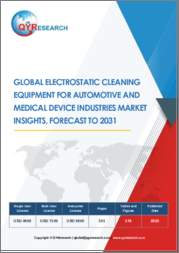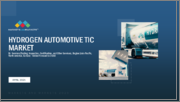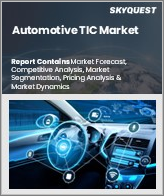
|
시장보고서
상품코드
1456892
세계의 자동차 시험,검사,인증 시장 예측(2024-2029년)Automotive Testing Inspection and Certification Market - Forecasts from 2024 to 2029 |
||||||
자동차 시험,검사,인증 시장은 2022년에 255억 8,200만 달러로 평가되었고 복합 연간 성장률(CAGR) 4.92%로 성장할 전망이며 2029년에는 343억 1,700만 달러 규모에 이를 것으로 예측됩니다
자동차 시험,검사,인증(TIC) 서비스는 자동차 TIC 생산자에게 효율성, 생산성 및 요구사항을 달성하기 위한 생산 공정을 개선하는 서비스를 제공하는 데 사용됩니다. 또한 레이더, 광검출, 거리 측정 등의 스마트 센서를 자동차에 사용함으로써 원격 감시와 유지보수 능력을 예측할 수 있어 현장 시험의 필요성이 줄어들었습니다. 그 결과 가상현실(VR)과 증강현실(AR)과 같은 TIC의 기술 개발은 물리적 차량시험을 디지털시험으로 대체하는 데 도움이 될 것으로 보입니다. 따라서 물리적 시험에서 디지털 시험과 예지 보전으로의 대체가 세계 자동차 시험, 검사, 인증 시장의 성장을 가속할 것으로 예측됩니다.
그러나 자동차시험,검사,인증시장에는 지역에 따라 다른 규제와 기준, 세계 자동차 판매 감소 등 시장의 잠재적인 성장을 방해할 것으로 예상되는 일정한 한계가 있어 해외 자격시험에 필요한 긴 리드 타임은 시장 성장에 도전을 줄 수 있습니다.
시장 성장 촉진요인:
- 자동차 제조 증가
신흥국에서의 자동차 제조 증가와 TIC 서비스 아웃소싱에 대한 사고방식의 급속한 변화는 자동차 시험,검사,인증 시장의 성장에 크게 영향을 미치고 있습니다. 신흥국의 가처분소득 증가와 자동차 부문에 엄격한 규제 요건을 부과하는 정부의 관심이 높아짐에 따라 자동차 시험,검사,인증 시장의 확대에 박차를 가할 것으로 예상됩니다. 게다가, 승객과 차량의 안전을 보장하기 위해 자동차 전자 제품의 사용은 예측 기간 동안 자동차 시험, 시험 및 인증 시장의 성장을 가속할 것으로 예측됩니다.
- 자동차의 안전성과 품질에 대한 주목의 향상
세계 자동차 산업은 환경 문제(배기 가스 수준, 연비, 소음, 오염)와 마찬가지로 승객의 안전을 규제하는 다양한 정부 규정에 의해 감독되고 있습니다. 이러한 규제 및 기준은 자동차 부품 설계에 직접적인 영향을 미치고 영향을 미칩니다. 엄격한 정부 규정에 따라 자동차 제조업체는 안전 벨트, 에어백, 클램프 존과 같은 안전 장비를 자동차에 장착해야합니다. 주요 규제기관은 불량 설비를 지속적으로 사용하는 등 공해 및 안전 기준을 위반하는 생산자를 처벌하고 억제하기 위해 관세 및 기타 무역 장애를 부과합니다. 이 때문에 자동차 제조업체는 배출가스를 대폭 삭감한 저연비차를 개발하여 횡미끄럼 방지 브레이크 시스템(ABS), 전자제어제동력배분시스템(EBD), 에어백, 터보차저 부착 촉매 컨버터 및 배기 가스 재순환 시스템(EGR) 등의 배출가스 제어 시스템과 같은 안전 기능을 추가할 필요가 있습니다.
시장 성장 억제요인:
- 규정과 기준은 지역에 따라 다릅니다.
거래와 기업의 세계화에 따라 특정 지역의 규제와 기준이 세계적으로 제품 채택의 장애가 될 가능성이 높습니다. 이는 지역 표준과 국제 표준 간의 분쟁으로 이어져 시장 확대를 방해합니다. 지역에 따라 규제 요건이 다르기 때문에 세율에 격차가 생겨 기업에 대한 추가 지출(세무 관련 문제를 처리하기 위한 현지 직원의 고용 등)이 발생합니다. TIC 사업에는 현지 규정이 적용되며 해당 국가의 법률 및 규범을 준수해야 하므로 효율성이 제한될 수 있습니다.
아시아태평양의 자동차 시험,검사,인증 시장은 크게 성장할 것으로 예상됩니다.
아시아태평양은 시장의 대부분을 차지하고 있으며 예측 기간 동안에도 우위를 유지할 것으로 예상됩니다. 이 지역의 신흥 경제 국가, 1인당 소득 상승, 수요 증가, 유리한 정부 정책 투자 가능성은 이 지역의 생산 능력 확대를 목표로 하는 자동차 제조업체들의 주목을 받고 있습니다. 그 결과, 자동차 생산과 서비스 산업의 기술 혁신이 촉진되고, 이 지역 시장은 강력한 성장을 이루고 있습니다. 또한 자동차 판매량과 생산량 증가, 프리미엄 자동차와 자율주행 차량에 대한 수요 증가, 전기자동차 경사 증가, 자동차 안전과 품질에 대한 정부의 엄격한 정책, 자동차 산업의 기술 진보가 자동차 제조업체 시장 확대를 촉진하고 자동차 제조업체의 성장을 뒷받침하고 있습니다. 그 결과, 자동차 시험,검사,인증 시장의 성장을 뒷받침하고 있습니다.
주요 발전:
- 2023년 10월, Kugler Maag Cie by UL Solutions는 멕시코와 브라질에서 Automotive SPICE(R) 기능의 확장을 발표했습니다. 이러한 신제품에는 개발 워크숍, 교육, 평가 및 프로세스 최적화에 대한 지원이 포함됩니다. Kugler Maag Cie by UL Solutions는 자동차 산업을 지원하는 프로세스 우수성, 평가 및 교육 솔루션의 세계 공급업체입니다.
- 2023년 3월, 11개국에서 연간 1,300만건 이상의 시험을 실시하고, 자동차 시험 업계에서 유명한 스페인의 다국적 기업인 Applus가 스페인에서 PTI 시험의 사용자 경험을 향상시키기 위해 eReformas 디지털 플랫폼 을 구축했습니다.
목차
제1장 서론
- 시장 개요
- 시장의 정의
- 조사 범위
- 시장 세분화
- 통화
- 전제조건
- 기준년과 예측년의 타임라인
- 이해 관계자에게 있어서의 주요 이점
제2장 조사 방법
- 조사 디자인
- 조사 과정
제3장 주요 요약
- 주요 조사 결과
- CXO의 시점
제4장 시장 역학
- 시장 성장 촉진요인
- 시장 성장 억제요인
- Porter's Five Forces 분석
- 업계 밸류체인 분석
- 애널리스트 보기
제5장 자동차 시험,검사,인증 시장 : 서비스별
- 소개
- 시험
- 검사
- 인증
제6장 자동차 시험,검사,인증 시장 : 조달별
- 소개
- 아웃소싱
- 사내
제7장 자동차 시험,검사,인증 시장 : 용도별
- 소개
- 텔레매틱스
- 전기 시스템 및 부품
- 내외장재
- 인증시험
- 기타
제8장 자동차 시험,검사,인증 시장 :지역별
- 소개
- 북미
- 남미
- 유럽
- 중동 및 아프리카
- 아시아태평양
제9장 경쟁 환경과 분석
- 주요 기업과 전략 분석
- 시장 점유율 분석
- 합병, 인수, 합의 및 콜라보레이션
- 경쟁 대시보드
제10장 기업 프로파일
- Bureau Veritas SA(Wendel)
- SGS SA
- Dekra Group
- Intertek Group Plc
- TUV SUD
- BSI Group
- TUV Nord Group
- ATIC
- Applus
- NTS
The automotive testing inspection and certification market is evaluated at US$25.582 billion for the year 2022 growing at a CAGR of 4.92% reaching the market size of US$34.317 billion by the year 2029.
The automotive testing, inspection, and certification (TIC) services are used to provide automotive TIC producers with services to improve efficiency, productivity, and the production process to achieve the requirements. Furthermore, the use of smart sensors in vehicles, such as radar, light detection and ranging, and others, has enabled remote monitoring and prediction of maintenance capabilities, reducing the need for on-site inspection. As a result, technological developments in TIC, like virtual reality (VR) and augmented reality (AR), will aid in the replacement of physical vehicle inspection with digital inspection. Hence, the replacement of physical inspection with digital inspection and predictive maintenance is projected to fuel the worldwide automotive testing, inspection, and certification market growth.
However, the automotive testing, inspection, and certification market has certain limitations that are expected to obstruct the market's potential growth, such as varying regulations or standards across regions and declining global vehicle sales, while the long lead time required for overseas qualification tests can challenge the market's growth.
MARKET DRIVERS:
- Rise in automobile manufacturing.
The rise in automobile manufacturing in emerging nations, as well as the quick shift in attitude toward outsourcing TIC services, are significantly affecting the automotive testing, inspection, and certification market growth. The increasing disposable incomes in emerging nations, and the increased focus of governments on imposing rigorous regulatory requirements on the automobile sector, are expected to fuel the automotive testing, inspection, and certification market expansion. Furthermore, the use of automotive electronics to ensure passenger and vehicle safety is projected to drive the automotive testing, inspection, and certification market growth during the forecast period.
- Increasing focus on automobile safety and quality.
The global automobile industry is supervised by a variety of government rules regulating passenger safety as well as environmental issues (emission levels, fuel economy, noise, and pollution). These regulations/standards have a direct impact on and affect the design of automotive parts. Strict government regulations require automakers to include safety equipment like seatbelts, airbags, and crumple zones in their vehicles. Major regulatory organizations impose tariffs and other trade obstacles to penalize and deter producers from violating pollution and safety standards, such as the continuous use of faulty equipment. This compels automakers to create fuel-efficient vehicles with significantly lower emissions, as well as add safety features such as anti-skid braking systems (ABS), electronic brake-force distribution (EBD), airbags, and emission control systems such as catalytic converters with turbochargers and exhaust gas recirculation (EGR) systems.
MARKET RESTRAINTS:
- Regulations and/or standards differ across regions.
With the globalization of trades and companies, specific regional regulations and standards are likely to create hurdles to product adoption on a global scale. This leads to disputes between local and international standards, impeding market expansion. Variations in regulatory requirements across different regions result in disparities in tax rates, incurring additional expenditures for businesses (hiring local staff to handle tax-related issues, etc.). Local regulations apply to TIC businesses, and they are required to obey the laws and norms of the countries in which they operate, which might limit their efficiency.
The Asia Pacific automotive testing inspection and certification market is anticipated to grow significantly.
The Asia Pacific holds the majority of the global market and is expected to maintain its dominance during the projected period. The developing economies in this region, rising per capita income, rising demand, and more investment possibilities due to favorable government policies are attracting the attention of automobile manufacturers, who are looking to expand their production capacity in this region. This, in turn, leverages the technological revolution of the automobile production and service industries, resulting in the region's strong market growth. Furthermore, rising auto sales and production, rising demand for premium and autonomous vehicles, rising inclination toward electric cars, stringent government policies for vehicle safety and quality, and technological advancement in the automotive industry are encouraging automakers to expand in the market, thereby boosting automaker growth. As a result, it boosts the automotive testing inspection and certification market growth.
Key Developments:
- In October 2023, Kugler Maag Cie by UL Solutions announced the expansion of its Automotive SPICE(R) capabilities in Mexico and Brazil. These new products include development workshops, training, assessments, and assistance for process optimization. Kugler Maag Cie by UL Solutions is a global supplier of process excellence, evaluation, and training solutions that assist the automobile industry. It is part of UL Solutions' automotive portfolio.
- In March 2023, the eReformas digital platform was created by Applus+, a well-known Spanish multinational in the vehicle inspection industry with over 13 million inspections performed annually across 11 countries, to enhance the PTI test user experience in Spain.
Segmentation:
By Service
- Testing
- Inspection
- Certification
By Sourcing
- Outsourced
- In-house
By Application
- Telematics
- Electrical Systems & Components
- Interior & Exterior Material
- Homologation Testing
- Others
By Geography
- North America
- United States
- Canada
- Mexico
- South America
- Brazil
- Argentina
- Others
- Europe
- UK
- France
- Germany
- Italy
- Others
- Middle East and Africa
- Saudi Arabia
- UAE
- Others
- Asia Pacific
- Japan
- China
- India
- Thailand
- Taiwan
- Indonesia
- Others
TABLE OF CONTENTS
1. INTRODUCTION
- 1.1. Market Overview
- 1.2. Market Definition
- 1.3. Scope of the Study
- 1.4. Market Segmentation
- 1.5. Currency
- 1.6. Assumptions
- 1.7. Base, and Forecast Years Timeline
- 1.8. Key Benefits to the stakeholder
2. RESEARCH METHODOLOGY
- 2.1. Research Design
- 2.2. Research Processes
3. EXECUTIVE SUMMARY
- 3.1. Key Findings
- 3.2. CXO Perspective
4. MARKET DYNAMICS
- 4.1. Market Drivers
- 4.2. Market Restraints
- 4.3. Porter's Five Forces Analysis
- 4.3.1. Bargaining Power of Suppliers
- 4.3.2. Bargaining Power of Buyers
- 4.3.3. Threat of New Entrants
- 4.3.4. Threat of Substitutes
- 4.3.5. Competitive Rivalry in the Industry
- 4.4. Industry Value Chain Analysis
- 4.5. Analyst View
5. AUTOMOTIVE TESTING INSPECTION AND CERTIFICATION MARKET BY SERVICE
- 5.1. Introduction
- 5.2. Testing
- 5.2.1. Market Trends and Opportunities
- 5.2.2. Growth Prospects
- 5.2.3. Geographic Lucrativeness
- 5.3. Inspection
- 5.3.1. Market Trends and Opportunities
- 5.3.2. Growth Prospects
- 5.3.3. Geographic Lucrativeness
- 5.4. Certification
- 5.4.1. Market Trends and Opportunities
- 5.4.2. Growth Prospects
- 5.4.3. Geographic Lucrativeness
6. AUTOMOTIVE TESTING INSPECTION AND CERTIFICATION MARKET BY SOURCING
- 6.1. Introduction
- 6.2. Outsourced
- 6.2.1. Market Trends and Opportunities
- 6.2.2. Growth Prospects
- 6.2.3. Geographic Lucrativeness
- 6.3. In-House
- 6.3.1. Market Trends and Opportunities
- 6.3.2. Growth Prospects
- 6.3.3. Geographic Lucrativeness
7. AUTOMOTIVE TESTING INSPECTION AND CERTIFICATION MARKET BY APPLICATION
- 7.1. Introduction
- 7.2. Telematics
- 7.2.1. Market Trends and Opportunities
- 7.2.2. Growth Prospects
- 7.2.3. Geographic Lucrativeness
- 7.3. Electrical Systems & Components
- 7.3.1. Market Trends and Opportunities
- 7.3.2. Growth Prospects
- 7.3.3. Geographic Lucrativeness
- 7.4. Interior & Exterior Material
- 7.4.1. Market Trends and Opportunities
- 7.4.2. Growth Prospects
- 7.4.3. Geographic Lucrativeness
- 7.5. Homologation Testing
- 7.5.1. Market Trends and Opportunities
- 7.5.2. Growth Prospects
- 7.5.3. Geographic Lucrativeness
- 7.6. Others
- 7.6.1. Market Trends and Opportunities
- 7.6.2. Growth Prospects
- 7.6.3. Geographic Lucrativeness
8. AUTOMOTIVE TESTING INSPECTION AND CERTIFICATION MARKET BY GEOGRAPHY
- 8.1. Introduction
- 8.2. North America
- 8.2.1. By Service
- 8.2.2. By Sourcing
- 8.2.3. By Application
- 8.2.4. By Country
- 8.2.4.1. United States
- 8.2.4.1.1. Market Trends and Opportunities
- 8.2.4.1.2. Growth Prospects
- 8.2.4.2. Canada
- 8.2.4.2.1. Market Trends and Opportunities
- 8.2.4.2.2. Growth Prospects
- 8.2.4.3. Mexico
- 8.2.4.3.1. Market Trends and Opportunities
- 8.2.4.3.2. Growth Prospects
- 8.2.4.1. United States
- 8.3. South America
- 8.3.1. By Service
- 8.3.2. By Sourcing
- 8.3.3. By Application
- 8.3.4. By Country
- 8.3.4.1. Brazil
- 8.3.4.1.1. Market Trends and Opportunities
- 8.3.4.1.2. Growth Prospects
- 8.3.4.2. Argentina
- 8.3.4.2.1. Market Trends and Opportunities
- 8.3.4.2.2. Growth Prospects
- 8.3.4.3. Others
- 8.3.4.3.1. Market Trends and Opportunities
- 8.3.4.3.2. Growth Prospects
- 8.3.4.1. Brazil
- 8.4. Europe
- 8.4.1. By Service
- 8.4.2. By Sourcing
- 8.4.3. By Application
- 8.4.4. By Country
- 8.4.4.1. UK
- 8.4.4.1.1. Market Trends and Opportunities
- 8.4.4.1.2. Growth Prospects
- 8.4.4.2. France
- 8.4.4.2.1. Market Trends and Opportunities
- 8.4.4.2.2. Growth Prospects
- 8.4.4.3. Germany
- 8.4.4.3.1. Market Trends and Opportunities
- 8.4.4.3.2. Growth Prospects
- 8.4.4.4. Italy
- 8.4.4.4.1. Market Trends and Opportunities
- 8.4.4.4.2. Growth Prospects
- 8.4.4.5. Others
- 8.4.4.5.1. Market Trends and Opportunities
- 8.4.4.5.2. Growth Prospects
- 8.4.4.1. UK
- 8.5. Middle East and Africa
- 8.5.1. By Service
- 8.5.2. By Sourcing
- 8.5.3. By Application
- 8.5.4. By Country
- 8.5.4.1. Saudi Arabia
- 8.5.4.1.1. Market Trends and Opportunities
- 8.5.4.1.2. Growth Prospects
- 8.5.4.2. UAE
- 8.5.4.2.1. Market Trends and Opportunities
- 8.5.4.2.2. Growth Prospects
- 8.5.4.3. Others
- 8.5.4.3.1. Market Trends and Opportunities
- 8.5.4.3.2. Growth Prospects
- 8.5.4.1. Saudi Arabia
- 8.6. Asia Pacific
- 8.6.1. By Service
- 8.6.2. By Sourcing
- 8.6.3. By Application
- 8.6.4. By Country
- 8.6.4.1. Japan
- 8.6.4.1.1. Market Trends and Opportunities
- 8.6.4.1.2. Growth Prospects
- 8.6.4.2. China
- 8.6.4.2.1. Market Trends and Opportunities
- 8.6.4.2.2. Growth Prospects
- 8.6.4.3. India
- 8.6.4.3.1. Market Trends and Opportunities
- 8.6.4.3.2. Growth Prospects
- 8.6.4.4. Thailand
- 8.6.4.4.1. Market Trends and Opportunities
- 8.6.4.4.2. Growth Prospects
- 8.6.4.5. Taiwan
- 8.6.4.5.1. Market Trends and Opportunities
- 8.6.4.5.2. Growth Prospects
- 8.6.4.6. Indonesia
- 8.6.4.6.1. Market Trends and Opportunities
- 8.6.4.6.2. Growth Prospects
- 8.6.4.7. Others
- 8.6.4.7.1. Market Trends and Opportunities
- 8.6.4.7.2. Growth Prospects
- 8.6.4.1. Japan
9. COMPETITIVE ENVIRONMENT AND ANALYSIS
- 9.1. Major Players and Strategy Analysis
- 9.2. Market Share Analysis
- 9.3. Mergers, Acquisitions, Agreements, and Collaborations
- 9.4. Competitive Dashboard
10. COMPANY PROFILES
- 10.1. Bureau Veritas S.A. (Wendel)
- 10.2. SGS SA
- 10.3. Dekra Group
- 10.4. Intertek Group Plc
- 10.5. TUV SUD
- 10.6. BSI Group
- 10.7. TUV Nord Group
- 10.8. ATIC
- 10.9. Applus+
- 10.10. NTS



















